The Slovaks of Cleveland
![]()
|
NOTE: This document was published in 1918. Thanks to Daniel Isom for this significant contribution. |
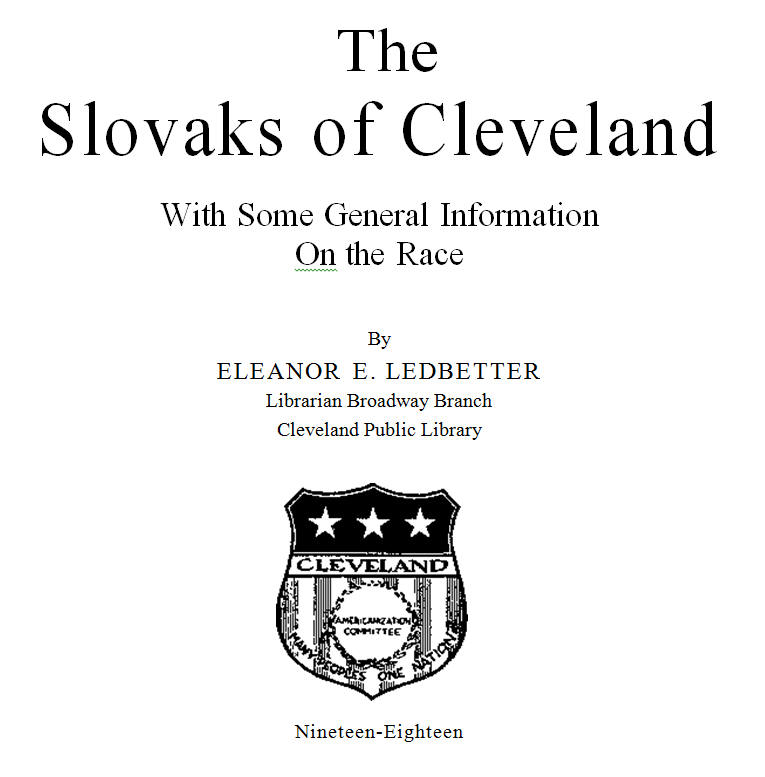

.
FOREWORD
As the work of the Cleveland Americanization Committee took on more definite
shape, it seemed to separate itself into two divisions; first, bringing the
foreign born residents into close touch with the language, customs and ideals of
America; and second, giving to the native born Americans an understanding of the
racial and political sympathies of the foreign born. Without a common
understanding of the best each has to offer, no real fusion of new and older
Americans will ever take place.
With this end in view, a series of articles has been planned, taking up
individually the various races prominently represented in our cosmopolitan city.
"The Slovaks of Cleveland" is presented as the first of this series. It is very
desirable that this race be better understood in view of the prominent part they
are now bearing in world politics. The establishment of a Czecho-Slovak state
will prove one of the best possible barriers to future German aggression, and
the annals of the Czecho-Slovak army in Russia are full of achievement as heroic
as any the world has ever seen.
The Czechs are well known by their English name, Bohemians, but there is very
little general understanding of the Slovaks. The adjective "Slavish" which is
sometimes used co describe them, has no standing in the dictionary and does not
appear in any ethnological work. Their own adjective "Slovensky" has often led
to their being confused with the Slovenians, who are an entirely different race.
In the census they figure as Hungarians because born in Hungary, and in other
records they appear as Austrians, because they have come from the
Austro-Hungarian monarchy.
It is hoped that this publication may be effective in securing for them a
better understanding.
HELEN BACON, Secretary.
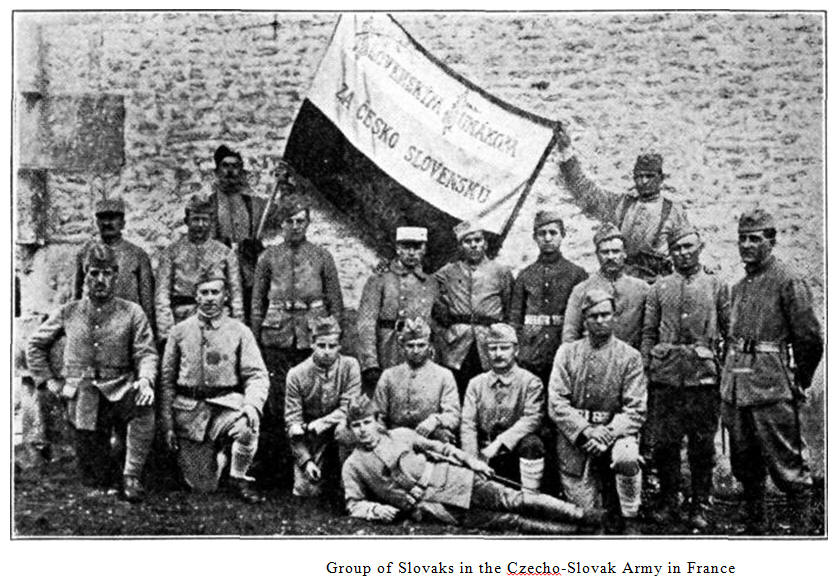
In The northern part of Hungary where the Carpathians slope
toward the great Hungarian plain, is the country called by its children
"Slovensko" or "Slovakland".
Racial Definition. History.
This region, comprising sixteen counties of Hungary, is the home of the Slovaks,
a historic race of solid character and exceeding industry, whose fate through
centuries has been aptly summarized in the statement that they are "the very
step-children of fortune."
It is a rough country, a country of mountainsides and valleys, and has been
inhabited by this same race since the fifth century. In the year 863 the
wonderful story of Christ was brought to the Slovaks by the apostles Cyril and
Methodius. In 870 A.D. their nation came for a brief space into the limelight of
history as the nucleus of the Great Moravian empire under Svatopluk, whose
capital was the city of Nitra. This kingdom was disrupted by Germans and Magyars
early in the next century, and for a thousand years the Slovaks have lived in a
state of vassalage to an alien race, the victims always of oppression and
suppression.
That under these circumstances they have been able to maintain their own
language and their national traditions through so great a period of time
indicates a remarkable tenacity, both mental and spiritual. Their only
fellowship has come from the west,—from their neighbors, the Moravians, and from
the Czechs (here commonly called Bohemians), who live west of the Moravians. The
Moravians and Bohemians use the Czech language. The Slovak tongue, while it is
counted a distinct language, is yet so much akin to the Bohemian that mutual
understanding is easy. This historic fellowship, so long continued, now looks to
find at the end of the present war, political fruition in the establishment of
an independent Czecho-Slovak state.
Hungary is the name of a political division. There are four principal races
within its confines, besides others of less numerical importance. The dominant
race, generally known in America as Hungarians, are from a racial standpoint
more correctly called Magyars. Then there are the Germans, with whom the Magyars
are hand in glove: while the step-children are the Rumanians in southeastern
Hungary, and the Slovaks in the northwestern part.
The Slovaks number more than 2,000,000 souls, possibly even 3,000,000, but this
can only be estimated, as the official census is notoriously unjust to all but
the ruling race. Throughout Hungary there are occasional "islands" of Slovaks,
but probably 2,000,000 at least live in the district called "Slovensko".
Economic Conditions.
This country is, except in certain limited portions, rough and rocky, with
considerable forests. The valleys and fertile lands are mostly owned by the
lords and nobles, absentee landlords all, or by the church, and to these the
peasant must give a certain number of days' work free each year. The roughest
portions, the shallowest soil, the mountainsides, uncultivable to the western
eye, are the farms of the Slovak peasant. In the spring and fall, manure is
painfully, toilingly carried in baskets up the steep slopes to furnish food for
the coming crops.
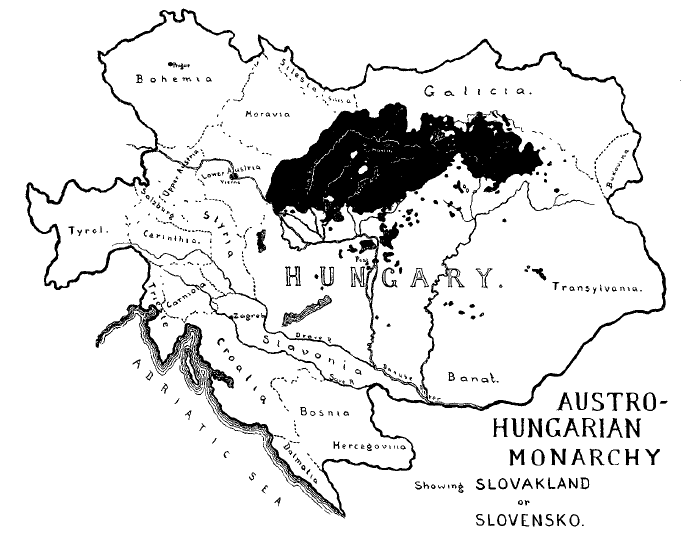
The prosperous "rich" peasant owns at most a dozen acres, not in one plot but in
strips, of ten miles apart, so that the labor of cultivation is multiplied
manyfold. The poor peasant may try to make a living from a part of an acre.
Failing to succeed in this, he leaves his wife and children to cultivate the
home plot, while he seeks employment abroad, usually as an agricultural laborer
in the plains of Hungary or he may go to the Eldorado, America.
Money the Slovak peasant has only twice a year,—when he returns from this
outside employment and when he harvests his own crops. But he does not have this
long, for the tax-collector takes most of it. If he has been more than usually
unfortunate, and has no money, the tax collector takes his household goods; for
kindness of heart or consideration for the individual or the community does not
influence the tax collector in Hungary.
Food.
The staple foods of the Slovak are black bread, the flour a mixture of barley
and rye, potatoes, cabbage, milk and cheese, and maize meal (corn meal).
Breakfast consists of black bread and a thin corn meal porridge. Dinner is a
soup thick with noodles or vegetables, or cabbage cooked in a rich gravy. If the
soup was made with meat, as happens sometimes, but not often, then the meat is
used as a separate dish. In the better parts of the country, there is a good
supply of such vegetables as beans, peas, carrots, and turnips. Supper usually
consists of potatoes with sour milk, or a corn meal mush with sour milk. Cottage
cheese is much used.
The fruits of the temperate climate, apples, plums, cherries, and apricots, all
are said by the exile to be particularly well flavored in eastern Slovensko, and
wild strawberries abound there. Children gather them and sell them for two cents
a quart. Huckleberries are also plentiful. Sheep cheese, called brindza, is a
favorite article of food, and before the war was imported and sold in a few
Cleveland stores. Mushrooms are much used. Plum brandy and juniper brandy are
home made drinks considered to have medicinal as well as social qualities.
Delicious pastries called kolace and pasky are luxuries to be enjoyed like white
bread, only on occasions such as Christmas, Easter, wedding and christening
celebrations. Meat is always a luxury, and one of the frequent recommendations
given by immigrants to America is that here there is "meat every day". Salt is a
government monopoly, ordinarily sold at ten or twelve cents a pound.
Education.
If the peasant's circumstances are passable and he does not live too far from a
town, he may send his children to school for four winters. The length of this
tetti is determined by agricultural conditions. It is usually from November to
about April, because the children must help to wrest a living from the soil.
Children have to work from an early age, usually from about six years of age and
they do work which we would consider it not only cruel, but impossible to ask
from our children. As one Cleveland child of Slovak parentage has said, "My
father says his children can never know how much better their childhood is than
his was". For their work, children are paid about five dollars a year, and the
day is from sunrise to sundown.
During these four terns of school, the Slovak child will receive instruction in
Magyar,—a foreign tongue, the language, not of his fathers, but of his
oppressors,—a language which the Slovak hates and never uses, except under
compulsion. He says with justice that the Slovak tongue will take him all over
the Slav world, while the Magyar has no value outside of Hungary. Consequently,
the child, studying in a hated language, which has for him no daily use, learns
very little, and finishes his four terms of school almost as ignorant as he
began. It is for him exactly what it would be for us now if our children were
compelled to receive their education in German. Never-the-less, he must in
self-defense learn some Magyar, since he will never be sold a railroad ticket
nor a postage stamp unless he asks for it in Magyar.
A peasant who is both prosperous and ambitious, who is willing to sacrifice what
few comforts he has, and to bend every resource to one purpose, may choose the
brightest of his children for a "higher education". For that the child must be
sent to the city and pay tuition, besides board and other expenses. This can be
done only if the would-be scholar himself seizes every opportunity and creates
opportunities as well, to help himself and to add to the meager allowance from
home. Great is his responsibility. If he should fail, it is failure, not for one
person only, but for all the family hopes.
And from the beginning he must go with an outward acceptance of Magyarization.
The students, Slovak though they may be, are allowed to converse in nothing but
Magyar, even in their most private moments. Always there are monitors whose duty
it is to spy upon and betray their comrades and the school authorities do not
hesitate to search rooms and trunks for such highly incriminating articles as a
little book of Slovak poetry, or a bit of handwriting in that language. Even a
student of theology is likely to be dismissed from the seminary and his whole
career blasted if he shows any interest in the language of his own home and of
his future flock. There is one clergyman in Cleveland to-day who twice saw
fellow students meet this fate and who came to America because he was
"discouraged" in consequence.
Military Service.
After graduating, the student has the privilege of volunteering for military
service, if he does so immediately, and as a volunteer he can go into the army
on terms which make it possible for him to become an officer in the re-serves at
the end of a year. If he does not volunteer, however, he is summoned for service
on the same terms as his brothers, who served for three years from the age of
twenty-one.
The treatment of privates in the Austrian army is unbelievably cruel.
In the first place, the poor Slovak must speak in German whether he knows how or
not. To answer in Slovak is one of the offences which may bring him a slap
across the face, or cruel confinement in the guard-house. Sent to the guardhouse
for some utterly trivial offence like failing to salute perfectly or having his
shoes not shining in the requisite degree, or speaking in Slovak, he may be
given bread and salt to eat and denied water for two or three days. Or his right
arm may be fastened to his left leg with clamps, and he kept in that position
for a day or two. A favorite punishment is to hang him up by a sort of harness
under the aims, drawn up so that his toes barely touch the ground. He will be
kept so until he grows black, then taken down, revived with a bucket of water
and hung up again. Many commit suicide under these punishments.
The soldier's pay is about three cents a day,—hardly enough for the absolutely
required shoe-polish, needles and thread and polish for his brass buttons. He
must have help from home during his whole period of service at a time of life
which ought to be most productive. It is quite obvious that he gains no new
loyalty to his rulers, except that which is instilled by fear.
The Making of Emigrants.
These conditions of political disaffection, of economic difficulty, of
oppressive taxation, with the denial of political representation, of language
and of education, naturally make for emigration, once a goal has been
discovered. The first Slovak emigrants to America, reporting that here they
found "good wages, better living, and free schools, to which any human being can
go" were naturally followed by others, until emigration became for some
districts almost an exodus.
To these people the freedom of America was a discovery almost as great as the
land itself had been to Columbus. What more natural than that they should soon
begin to work toward freedom as a possession of the whole Slovak race. This
desire found united expression in the foillation in May, 1909, of the Slovak
League, whose purpose is to promote the cause of liberty for the Slovaks
everywhere.
Slovak League.
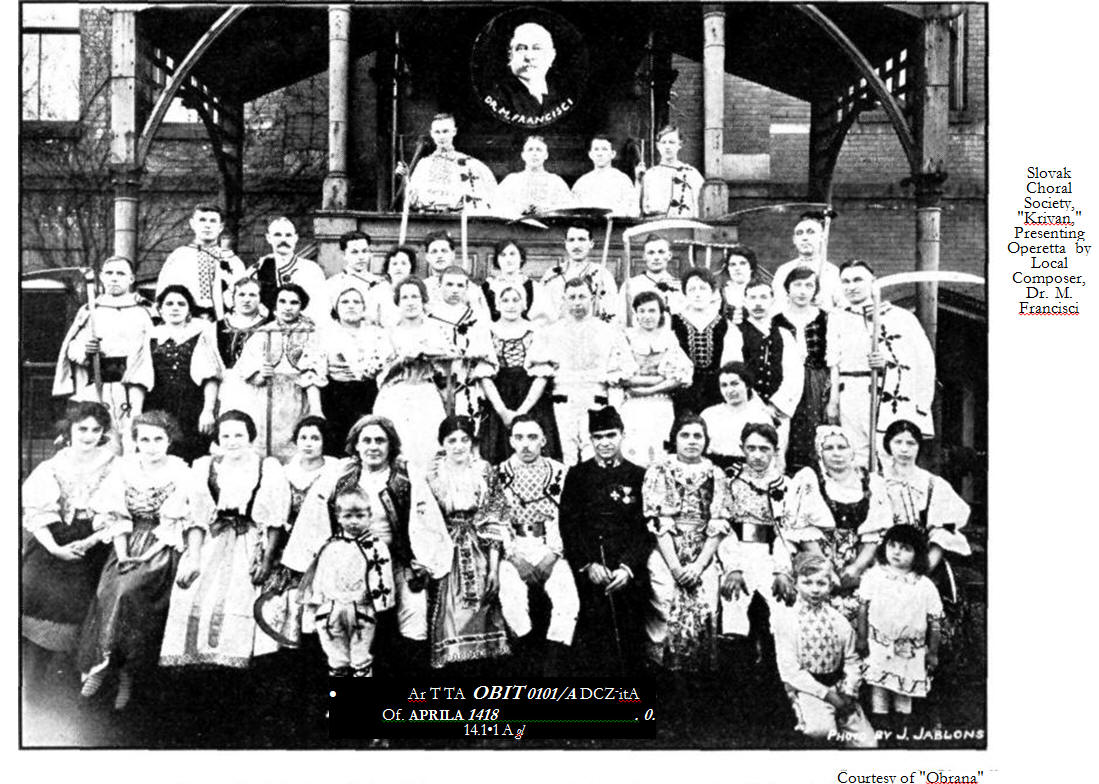
Since the beginning of the great war, this League has actively exerted itself to
direct public sentiment so as to secure for the race just treatment at
the break-up of the Austro-Hungarian monarchy; and to hasten that event by every
possible means. This activity has of course redoubled since the entrance of the
United States into the war, and especially since President Wilson expressed
himself in favor of self-determination of races and governments. "Nove
Slovensko" is a weekly newspaper just started (June, 1918) in Cleveland to
promote the objects of the League.
The Slovaks of this country have wisely joined forces with the larger Bohemian
organization in the fight for racial freedom, and a combination of working
forces has been effected in the organization of the "American Branch of the
Czecho-Slovak National Council". This Council consists of eight delegates each
from the Slovak League and from the Bohemian National Alliance. Mr. John Pankuch
of Cleveland is a member of the Council.
"The Bohemian Review" of March, 1918, makes this poignant statement: "Whereas
Bohemian immigrants in America constitute considerably less than ten per cent of
their race, one-fourth of the whole Slovak people live in America. The Bohemian
National Alliance does not and cannot speak for the Czech nation, for the Czechs
in the old country have their own accredited and regularly elected deputies. But
the Slovaks of Hungary have no elected representatives, and those who emigrated
to America must speak for the whole race". The president of the Slovak League is
Albert Mametej, of Braddock, Pa., secretary, John Jancek, an editor from Russia,
now in Pittsburgh.
Under the direction of the Council, the Slovaks share in the organization and
maintenance of the Czecho-Slovak army. A recruiting office is maintained in
Cleveland at 5286 Broadway. Men who are not of draft age, or who, because of
their technical classification as alien enemies (being nominally subjects of
Austria-Hungary) are not eligible to service in the United States army, are the
recruits.
This army is trained at a camp in Stamford, Conn., financed by the Council. As
soon as the soldiers embark for France, their expenses are met by the French
government which understands Austria's internal affairs enough to realize, as
our government has not done, that Austria's bitterest foes are those who have
grown up under her sovereignty. In France the Czecho-Slovaks fight under French
officers, but with their own organization, and carrying their own flag. (See
illustration on page 4.)
All Slovaks drafted for service in the United States army have waived exemption,
and they are among the most spirited of our soldiers, since they have not only
the patriotic motives which animate the rest of our army, but in addition a very
vigorous determination to pay off some of the old scores.
Slovak Immigration to America.
The first considerable number of Slovaks coming to America was 1,300 in 1873.
The largest number in any one year was 52,368 in 1905. Cleveland was a
destination for some from 1880, but up to 1886 most of their number settled in
the hard coal region of Pennsylvania, in the districts around Wilkes-Barre and
Scranton. Now they are scattered very widely through the whole United States,
with a few groups in Canada. About half the whole number, however, still is
found in Pennsylvania, with Ohio or Illinois probably second in number, and New
York, New Jersey and Connecticut following.
Slovaktown, Arkansas, is an agricultural community built up by Slovaks who
earned the money for their initial venture in the Pennsylvania coal fields.
Wherever they have settled in this country, the Slovaks have undertaken the
hard, heavy labor, the work fundamental to our great industries. Owing to their
lack of previous opportunity, they have always had to fall into the ranks of the
unskilled, where their dogged indu3try and perseverance have made them valuable,
and their uncomplaining submissiveness has sometimes made them the subjects of
exploitation.
The question naturally arises why more of them do not go to the country, when
practically all were agriculturists before emigration. Two answers are offered
in reply to this question; first, that the weekly pay envelope is irresistibly
attractive to people who had had so little money to handle in the old country;
and second, that in the city, the women also can work.
Among the Slovak immigrants, it has been very usual for the man of the family to
come first, often not intending to stay permanently. It was to him simply a
greater migration than the former habitual one to the plains of Hungary. Miss
Balch shows in "Our Slavic Fellow-citizen" pictures of "American" homes in
Slovensko, built by returned emigrants with the proceeds of American toil. Many
others, however, have on return found themselves so changed as to be out of
place in the old surroundings. An "American", returning to Hungary, is a thorn
in the flesh to the officials, to whom he no longer doffs the hat nor kisses the
hand. In consequence, passports for the second trip are often obtained more
easily than they were for the first, and the man who went home to stay, shortly
severs all ties and brings his family to America with him.
Others, without the experience of returning, analyze things for themselves and
conclude, "Why should I go back?"

After the War.
When the war comes to an end, there will however be a great exodus, caused by
the desire for immediate and accurate news of relatives, friends and homes from
whom the separation has been complete for so long. There are in Cleveland more
than 600 Slovak men whose families in Hungary were dependent upon remittances
from this country. The agonizing situation of these men, so long without news
and with so little reason for hope, is such as to make them subjects for the
keenest sympathy. It is safe to say that there is hardly a Slovak in Cleveland
who has not mother, wife, children, or sisters in the old country, and who will
not wish to see with his own eyes what the war has done to them. How long he
will stay depends upon economic and political conditions which it is impossible
now even to forecast.
Distribution of Slovaks in the United States.
The distribution of Slovaks in the United States is a subject on which it is not
possible to present any figures, as the census records do not indicate the race,
but count them in with all the other emigrants from Hungary.
Two methods of approximation of local populations are available: first, the
records of the Slovak churches in the United States; for the Slovaks are a
religious people, and there are comparatively few without a church connection.
Second, the records of the various societies, mostly beneficiary, which are
organized on a nationalistic basis; that is, only persons of Slovak ancestry are
eligible.
The establishment of a new Slovak church obviously means the presence of a
number of Slovaks sufficient in means and interest to buy property and to
maintain an institution. Similarly, the formation of a branch, or "lodge", of a
fraternal organization indicates the existence of a group able to meet and pay
dues, and desirous of receiving the benefits of the organization.
Distribution of Slovaks in Ohio.
The distribution of Slovaks in Ohio is indicated by the following list of towns
which have branches of one or more of these societies:
| Adena | Belle Valley | Cambridge | Congo |
| Amsterdam | Berea | Canton | Conneaut-Jester |
| Ashtabula | Black Top | Castalia | Danford |
| Ava | Bradley | Cincinnati | Dayton |
| Barberton | Buffalo | Clay Center | Dillonvale |
| Barton | Byesville | Cleveland | Dover |
| Bellaire | Caldwell | Coalridge | East Toledo |
| Fairport | Lorain | Murray City | South Lorain |
| Glencoe | Lowellville | Neffs | Steubenville |
| Gypsum | Lucasberg | Pine Fork | Stewartsville |
| Haselton | Mansfield | Pleasant City | Struthers |
| Hubbard | Marblehead | Port Clinton | The Plains |
| Kelley's Island | Martin's Ferry | Ramsey | Toronto |
| Kipling | Massillon | Rhodesdale | Walkers |
| Klondyke | Maynard | Robins | Wolf Run |
| Laferty | Middletown | Rossford | Wheeling Creek |
| Leetonia | Mingo Junction | Roswell | Yorkville |
| Lore City | Moxhala | Salem | Youngstown |
Cleveland became a goal for Slovak immigrants as early as 1880. Jacob Gruss
(see illustration on page 18), who with his wife came to America in that year,
was advised by a Bohemian employment agent in New York, to proceed to the mining
regions of Pennsylvania. Mr. Gruss preferred to work above ground, so the agent
said, "Why not go to Cleveland ? That is a new city, with lots of work."
Arriving here, Mr. Gruss, who now lives at 9627 Stoughton Avenue, found one
fellow countryman, a man named Roskos, already here. In 1881 a few more Slovaks
came to Cleveland, in 1882 a larger number.
"The Father of the Slovaks."
In March, 1882, arrived the Rev. Stephen Furdek, the first Slovak priest in
America. By a curious turn of fate, he came, however, to minister to the
Bohemians. Bishop Gilmour, of the Roman Catholic diocese of Cleveland, had
written to Prague for a priest for his rapidly increasing number of Bohemian
parishes, and Father Furdek, although a Slovak, only 24 years of age, and barely
through his theological studies, was chosen to answer the call. He arrived here
in March, 1882, and was ordained to the priesthood July 2nd, in St. Wenceslaus
Bohemian church, of which he became the pastor. Two years later, he was given
the task of organizing the new Bohemian parish of Our Lady of Lourdes, which
soon became the largest Bohemian parish in the city, and where he remained until
his death, Jan. 18, 1915.
While successful to the highest degree in his appointed work among the
Bohemians, Father Furdek was a man of such breadth of interest, of such large
ability, and of so much executive talent, that he was able from the first to act
also as a leader of the Slovaks. Becoming first the friend and counsellor of the
few whom he found already in Cleveland, his interest grew and broadened until he
became a national figure, and was everywhere affectionately known as "The Father
of the Slovaks."
Slovaks in Cleveland.
There is no official record which will show the growth of our Slovak population,
but in a general way it can be estimated and localized by reference to the
history of the Slovak churches of our city. By following their development, it
is possible to learn in what parts of the city Slovak centers have developed,
and at what time each new community has increased to the point of forming a new
religious organization.
In 1885 Father Furdek began holding Slovak services regularly in the chapel of
the Franciscan Brothers on Woodland Avenue, and so brought together into a
religious body the little group of Slovaks in Cleveland at that time.
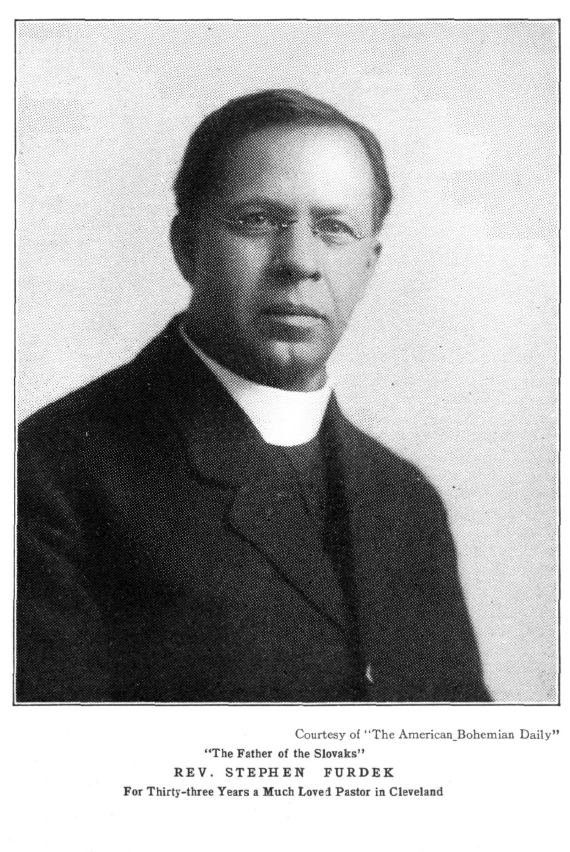

These first Slovaks had settled in the district around Hill,
Berg, Commercial, and Fourth Streets, but Father Furdek urged very strongly that
they find a more desirable location for their permanent home. Through his
influence a location was chosen in what was then the outskirts of the city,
along Buckeye Road and parallel streets from about East 78th Street to Woodhill
Road. Here the settlement rapidly grew, the Slovaks building small, neat
cottages.
In 1887, the collection of funds for a church was begun, and an organization was
effected Dec. 2, 1888. As there were Magyars living in the same neighborhood and
also in need of a church, an attempt was made to combine the two interests, and
the parish was named for the Magyar saint, St. Ladislas. It was not long before
difficulties began to arise between the two races, and eventually great
bitterness developed. The ensuing contest was settled by the Bishop, who decreed
that the Magyars should build themselves a new church, and that the Slovaks
should pay them $1,000 for their interest in St. Ladislas.
In recent years this neighborhood has changed very much, and the small homes of
the Slovaks have been largely crowded out by tenements, so that sixty-five per
cent of the original population have now moved farther out.
New property has been acquired on East Boulevard, at the foot of Sophia Avenue,
where it is planned first to erect a new school building, to be followed later
by a new church and other parochial buildings. The present parochial school
houses about 700 children, who are taught by the Sisters of Notre Dame..
Holy Trinity Evangelical Congregation.
The next Slovak parish organization was a Protestant one, the Holy Trinity
Evangelical Lutheran Congregation, founded Dec. 5, 1892. This was the third
Slovak Lutheran parish in the United States, the first having been in Freeland,
Pa.
Holy Trinity parish was established in the down town district, and although the
character of the local population has entirely changed several times, the
original location still seems most convenient to this congregation. The church
is at 2506 East 20th Street, where the parishioners find it easy to come from
all over the city.
There is a parochial school where two teachers give instruction to 65 children
in the work of the first four grades. For more advanced work, the children go to
the public schools, and attend special instructions in religion and the Slovak
language four hours a week in the parochial school. Additional property has
recently been acquired to furnish a playground for the children of the school.
While this church is one of the oldest Slovak organizations in the city, it is
an interesting fact that about half of the present congregation are immigrants
of the past six or eight years.
The pastor, Rev. Alexander Jarosi, is a Slovak from southern Hungary. Educated
in a Hungarian university, his coming to America was due to the fact that at the
very moment when he was feeling most bitterly the governmental oppression of his
native land, he received a letter from America telling him of the great need for
Slovak ministers here. Mr. Jarosi is keenly interested in assisting the men of
his congregation to become American citizens, and deplores the fact that so far
his Hungarian birth and his rank as an officer in the Austrian army, have caused
the refusal of his various applications for service in the United States army.
St. Martin's Church.
In the same neighborhood as Holy Trinity Church, the Roman Catholics founded St.
Martin's Church two years later, in 1894. This was first located on East 25th
Street; in 1902 a church was built on East 23rd Street, and in 1907 a larger one
was erected at the corner of East 23rd and Scovill Avenue. The old church is
used as a school building, and three dwelling houses have also been altered into
school rooms. Five hundred and fifty children are enrolled, the teachers being
the Sisters of St. Joseph. Two young men from this parish are now studying for
the priesthood.
The development of these three parishes may be taken to indicate the character
and location of the first phase of Slovak immigration to Cleveland.
Nationalistic Societies.
During this period from 1880 to 1894 the Slovak population of the United States
increased in very much the same proportion as did the Slovak population of
Cleveland, and in 1890 sufficient impetus had been gained to lead to the
establishment of the first of the nationalistic societies which are so large a
feature of Slovak life in America.
National Slovak Society.
February 16, 1890 marked the beginning of the movement. On that date was
organized in Pittsburgh under the leadership of P. V. Rovnianek, "The National
Slovak Society of the United States of America." (Narodny Slovensky Spolok v
Spojenych Statoch Americkych). Its aims, as stated in the "Constitution and
By-laws, 1916," are:
"To educate the Slovak immigrants, who, being victims of unfavorable political
conditions in their own country, were deprived of the means of education and
culture; to make of its members all sons of their nation; to teach them to love
their adopted country and to become useful citizens of this Republic; to help
one another in sickness and distress and to help the widows and orphans when
their breadwinners have passed away."
The duties of members as defined by the By-Laws, include the following: "He must
lead a moral life, make an honest living, and refrain from acts which would
bring disgrace upon the National Slovak Society, and dishonor to the Slovak
race." "It shall be the duty of every member to become a citizen of the United
States within six years after his admission to the Society. If he neglects to do
so, a complaint shall be filed against him in the Supreme Court."
Five "funds" are maintained: Mortuary fund, for the payment of death benefits;
administration fund, for the running expenses of the organization; indigent
fund, for the relief of disabled members who have exhausted the benefits to
which they are entitled from their local societies, but who are in extreme want;
a national fund, for "the moral development and for the uplifting of the honor
and good name of the Slovak nation"—from this students may be educated and
national purposes promoted; an orphans' and old folks' home fund.
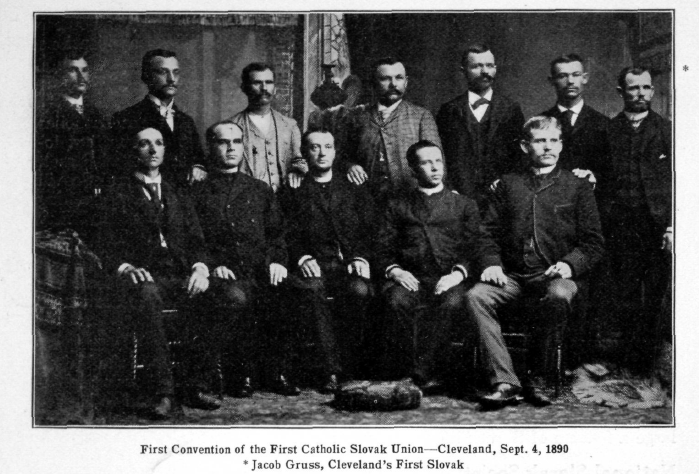
The official motto of the society is "Freedom, Justice, Brotherhood." It has 700
branches, widely distributed throughout the United States and Canada, with
42,259 members, and 7,500 junior members. 6,513 members have died, and their
beneficiaries have received $4,527,804.96. Sickness and accident benefits paid
have aggregated $85.228.86. The present capital is $1,870,869.56. Albert
Mametej, Braddock, Pa., is president and Joseph Durish, Pittsburgh is secretary.
"Narodny Noviny" (National News) a weekly newspaper, is the official organ of
the society. The Literary Committee is a standing committee of the society,
whose duty it is to provide for the publication of useful books for the members.
First Catholic Slovak Union.
On the fourth of September of the same year, another society of similar aims was
started in Cleveland by the Rev. Stephen Furdek. The first convention was held
in the home of Jacob Gruss, and was attended by eleven delegates (see
illustration on this page.)
This society was called the First Catholic Slovak Union (Prva Katolicka
Slovenska Jednota) and its membership is limited to Roman Catholics or Greek
Catholics in good standing. Its headquarters are in Cleveland, where the
secretary has a suite of offices in the Guardian Building.
"Every member of this Union shall become a citizen of the United States within
six years after his arrival in this country, and as a true son of the Slovak
nation he shall cultivate the Slovak language and nationality inherited from his
forefathers, preserve it for coming generations, and thus become worthy of his
ancestors." (Extract from the Constitution.)
The first Catholic Slovak Union now has a membership of 50,049
with 19,690 junior members. It has paid out in benefits $5,000,000 and has a
capital of $1,532,671.49. The capital of the junior society is $57,513.21. A. J.
Pirhalla, Duquesne, Pa. is president, Michael Senko, Cleveland, secretary.
The distribution of branches is as follows:
| Pennsylvania | 302 | Minnesota | 6 | Arkansas | 2 | ||
| Ohio | 72 | Missouri | 6 | Wyoming | 2 | ||
| Illinois | 55 | Colorado | 6 | Louisiana | 1 | ||
| New York | 33 | Maryland | 4 | Georgia | 1 | ||
| New Jersey | 29 | Washington | 3 | Oklahoma | 1 | ||
| Connecticut | 20 | Maine | 3 | New Mexico | 1 | ||
| Wisconsin | 13 | Montana | 3 | Virginia | 1 | ||
| Michigan | 12 | Massachusetts | 3 | Alabama | 1 | ||
| West Virginia | 9 | Kansas | 3 | California | 1 | ||
| Indiana | 7 | Iowa | 2 | Canada | 7 |
"Jednota" (Union), the official publication, was started by
Father Furdek as a small sheet in 1890, and was edited in Cleveland continuously
for the first ten years, and intermittently since, the annual convention
determining the place from year to year. It is a weekly paper, taken by all
members, and is now published in Middletown, Pa.
The Catholic Slovak Ladies' Union.
This is a society for men; the Slovak women were no more to be outdone than
their American sisters would be, so they founded in January, 1892, "The Catholic
Slovak Ladies' Union" (Katolicka Slovenska Zenska Jednota). The organization and
by-laws are like those of the brother organization. They have capital to the
amount of $429,049.48, of which $240,000 has been invested in Liberty Bonds.
There are 388 branches, having a total of 26,044 members, with representation in
26 states and Canada.
The headquarters of the Union are in Cleveland, where Mrs. Anna Ondrej, 3134
East 94th Street, is national president, and Mrs. Maria E. Grega, 9619 Orleans
Avenue, is general secretary. The official organ "Zenska Jednota" (Ladies'
Union) is edited and published at 5103 Superior Avenue by the chaplain, Rev.
John M. Liscinsky.
The Slovak Evangelical Union.
Naturally the next organization to be founded was of the opposite religious
faith, the Evangelical. The Slovak Evangelical Union (Slovenska Evanjelicka
Jednota) was founded in Freeland, Pa. in 1893. Its objects also are fraternal.
Its capital is $230,225; it has paid out in death benefits for men $741,674; for
women $77,755; for accidents, $43,399. It has 199 branches, and 58 junior
branches, 10,584 members.
Its headquarters are now in Allegheny, Pa. The president is Jan Matta,
Brownsville, Pa.; secretary Jan B. Bialek, 1601 Beaver Ave. Pittsburgh.
Its official publication is Slovensky Hlasnik (Slovak Herald) published weekly
in Pittsburgh. This also serves as organ for the sister society, the Evangelical
Slovak Ladies' Union.
The Evangelical Union has been unfortunate in the matter of unity, and an
offshoot from it is the National Slovak Western Union, with headquarters in
Chicago, and the Evangelical Slovak Union, founded in 1909 in Cleveland, of
which John Pankuch of Cleveland is president and Stevan Alusie, of 1928 Mead
Avenue, Racine, Wis. is general secretary.
Cleveland Slovak Union.
A local organization along the same lines but non-sectarian in membership is The
Cleveland Slovak Union, founded in 1899. It has in Cleveland 26 branches, with
1367 members and a capital of $49,485. The main society pays death benefits
only, the branches pay also accident and sickness benefits. The president is
George Putka, 2626 East 130th Street.
The objects of the Cleveland Slovak Union are stated as follows: "To educate the
Slovak people, who have been deprived of the privilege of education by
unfavorable circumstances in their fatherland; to foster intelligence among the
members, to teach them to love the new fatherland, and make useful American
citizens of them; to support the widows and orphans in case of the death of
members."
Sokols.
Another motive, that of physical culture and training, is a prime object in the
Slovak Gymnastic Union Sokol (Telovicna Slovenska Jednota Sokol). This had on
May 1st, 1918, 10,838 members, most of the chapters being in the states of New
Jersey, New York, Massachusetts, Connecticut, Pennsylvania, Ohio and Illinois.
Its headquarters are in Perth Amboy, New Jersey, where it was organized July
4th, 1896. The president is Stephen Erhardt, Bridgeport, Conn., the secretary
Frantisek Stas, Perth Amboy.
"Slovensky Sokol" (Slovak Falcon) published semi-monthly at 1424 Vyse Ave. New
York, keeps the members in touch with the organization.
"The Roman and Greek Catholic Gymnastic Slovak Sokol Union" (Rimsko a Gr.
Katolicka Telovicna Slovenska Jednota Sokol) is a similar organization limited
to a Catholic membership. It was organized in 1905 in Passaic, N. J., has 15,000
members, $100,000 capital, and owns a printing establishment valued at $15,000.
Its publications are "Katolicky Sokol," weekly, and a monthly juvenile
periodical, "Priatel Dietok".
Each of these national orders has many branches and hundreds of members in
Cleveland, and it is doubtless due to their beneficiary features in addition to
the natural thriftiness of the race that the number of Slovaks who appear as
applicants for charitable aid, is extremely small.
The great danger seems to be that an individual may take out membership in more
societies than he can afford to carry.
The meeting places of these various "lodges" are often in the parochial school
buildings, or in rented halls equipped for that purpose.
Slovak National Home.
The "Narodny Slovensky Dom" (Slovak National Home) Corporation erected in 1906 a
building at 8804 Buckeye Road to serve as a general center for Slovak
organizations and activities. Its management has unfortunately not been entirely
successful, and its ownership is now vested in M. N. Soboslay, a prominent
Slovak, who regards it as held in trust for its original purposes.
Second Stage of Growth.
The second stage in the growth of Cleveland's Slovak population is indicated by
the fact that at the end of ten years, the three churches already described, St.
Ladislas, Holy Trinity, and St. Martin's, were no longer sufficient to care for
the needs of the race, and a new era of church building set in.
St. Wendelin's Church.
A settlement had grown up on the West Side, which was formed in May, 1903, into
the parish of St. Wendelin. The original settlement was in the district bounded
by West 17th and West 22nd Streets, Lorain Avenue and Columbus Road. More
recently the Slovaks have moved into the old Lincoln Heights neighborhood,
between West 5th and West 11th Streets. There are also about 80 Slovak families
near Denison Avenue.
The present church of St. Wendelin was built in the year of the parish's
organization, and has for some time been inadequate to the needs of the greatly
increased membership. Property has been purchased at Columbus Road and Freeman
Avenue where new buildings will be erected after the war. The parochial school
of St. Wendelin has 900 pupils, the teachers belonging to the Sisters of Notre
Dame.
St. John's Church.
In 1905 the parish of St. John on West 11th Street was founded. It has so far
had a checquered history, due to a lack of approval on the part of the Roman
Catholic bishop of the Cleveland diocese. It is now affiliated with the
Independent Diocese of Scranton, Pa. under the Right Reverend Francis Hodur, and
has a settled pastor in the person of the Rev. Stephen Vincent Tokar, a young
American, the son of Slovak parents, born in Pennsylvania.
A fine church building is just about to be begun, and the parish seems to be on
the threshold of a brighter future.
Nativity Church.
The same influences of industrial opportunity and increased immigration which
led to the establishment of St. Wendelin's, had also been the occasion of great
growth at St. Ladislas, and the extension of its territory to an unwieldy
extent. As a result, the parish of St. Mary of the Nativity was formed in 1903.
This is east of the Newburg plant of the American Steel and Wire Company, in the
neighborhood of East 93rd Street and Aetna Road. While conveniently near the
mills for the men who are employed there, the land is so much higher that the
air is clean and clear. It is a district of home owners, of comfortable single
or two-family houses, neat yards and well tilled gardens. Its orderly
development has been inspired since 1909 by a pastor who is a true shepherd of
his flock, the Rev. V. A. Chaloupka.
This year the spirit of neighborhood improvement was so general that over 6,000
ornamental shrubs were set out, besides small fruit and shade trees.
The Nativity school building erected in 1916, is built according to the most
improved models, and possesses features which make it a genuine community
center. Its large auditorium, which seats 800, is in use every Sunday evening,
and often during the week. Sometimes the dramatic club gives a play, sometimes
there is a lecture on some topic of the hour, sometimes a dance with an
attendance of 250 couples, but oftenest the entertainment provided is moving
pictures. Father Chaloupka chooses the films, and intersperses the instructive
with the merely entertaining. One night last winter 1,100 people enjoyed moving
pictures depicting religious scenes.
The bowling alley is a feature of the school building much appreciated by the
young men of the neighborhood, and the women have classes in the various
branches of domestic science and in Red Cross work.
Night school classes in English and citizenship were held last winter under the
direction of the Americanization Committee, Father Chaloupka having himself
previously taught citizenship classes, also acting as witness for his men in
naturalization court.
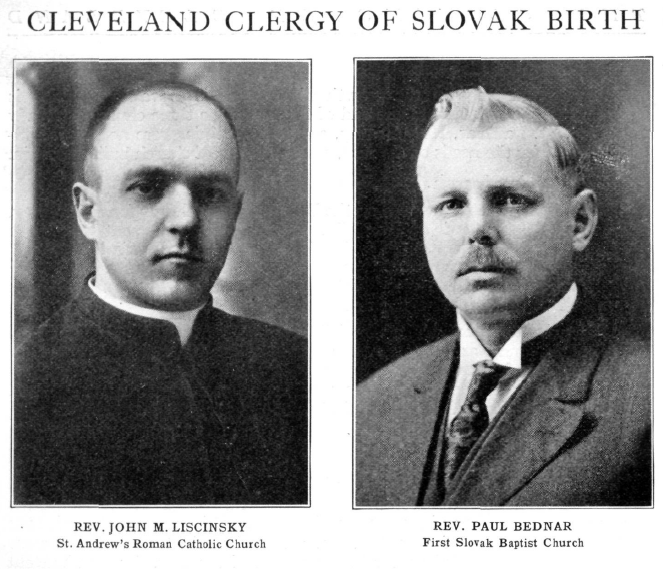
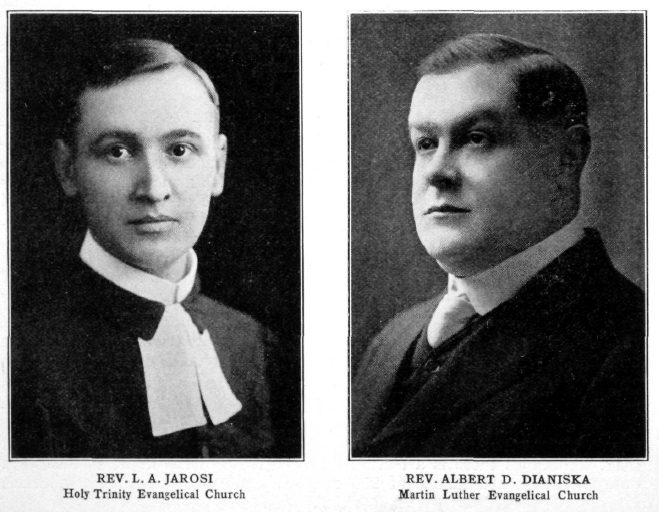
St. Andrew's
Church.
The youngest Roman Catholic Slovak church in the city is Sc. Andrew's on
Superior avenue, near East 55th street. This also is to some extent an outgrowth
of St. Ladislas parish, many of the families having moved to this neighborhood
because of its nearness to their employment in the various large manufacturing
plants north of Superior avenue, on Lakeside avenue, and along the Nickel Plate
tracks. They are buying homes in the neighborhood as fast as the former
residents are willing to sell . . This parish was organized in 1906, the church
was dedicated in 1907. Rev. John M. Liscinsky, who has been rector since 1908,
has the distinction of being the only Roman Catholic priest in the city who is
Slovak born, the others being Bohemians and Moravians.
Martin Luther Evangelical Congregation.
The Martin Luther Slovak Evangelical Lutheran Congregation was founded in 1910,
and used a dwelling at 2139 West 14th St. as a church until 1917. The
four-hundredth anniversary of the Reformation was celebrated by this
congregation with the opening of their new church. The structure is of red
brick, very pleasing in style. The Slovak Protestants trace their history back
to the refoillation of John Huss, so in the decorations of this church the
coat-of-arms of Martin Luther is balanced by "The Cup", the emblem of the
Hussites.
Rev. Albert D. Dianiska, the pastor, is a Slovak, whose father and grandfather
before him were Lutheran ministers. Mr. Dianiska has in his library manuscript
volumes of devotion which they used in the dark days of religious persecution,
in Hungary when meetings could be held only in secret, and printed books were
not available.
Greek Catholic Church.
In a religious survey of the Slovaks, consideration must also be given to the
Greek Catholic Church. This is a church whose existence is hardly known to
Americans, much less understood by them. It is a result of the efforts of the
Roman Catholic Church to convert the Greek Orthodox Russians. In the year 1595,
this effort reached a degree of success among the Little Russians (or
Ukrainians), who consented to acknowledge the supreme headship of the Pope, and
to accept the filioque clause in the creed, on condition of being allowed to
retain various practices of the Eastern Church. They retain the mass in Slavonic
instead of in Latin, the Eastern arrangement of the church, with the great gilt
screen in front of the altar, the communion in both kinds to the laity, the
married clergy, the Eastern form of the cross, with three cross-bars, the lowest
oblique, the Cyrillic alphabet, and the calendar thirteen days behind the Roman.
Most of the Little Russians are Greek Catholics; so also are those of the same
race who live across the border in Galicia and in the adjoining part of northern
Hungary. In Hungary this race is called by various names; perhaps Ruthenian is
the best known. They are a Slav race, akin to the Slovaks, who adjoin them on
the west. It is quite natural that where they meet and mingle, there should be
mingling of religious faiths. Consequently a considerable number of Slovaks are
Greek Catholics, but it is very difficult to get accurate information on the
subject, so far as Cleveland is concerned.
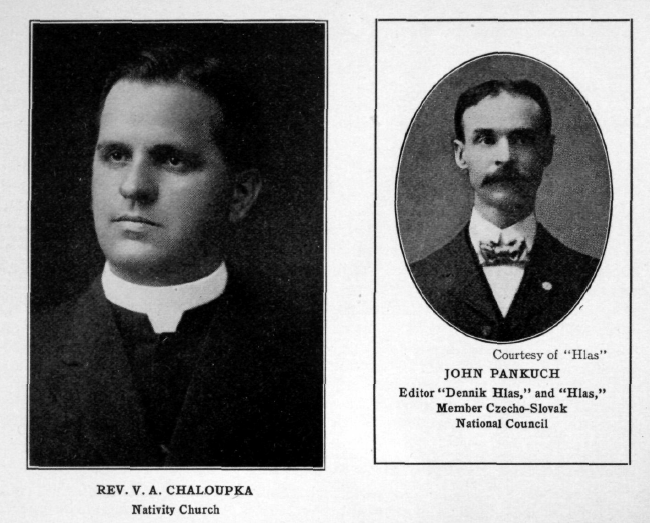
It is noticeable that in every Slovak community there is a Roman Catholic
church; then later a Greek Catholic church is formed in the same neighborhood.
St. John the Baptist Greek Catholic Church on Scovill Avenue, which has recently
gone over to the Greek Orthodox communion, and the Church of the Holy Ghost on
Kenilworth Avenue near West 14th Street are undoubtedly made up in part of
Slovaks. St. Joseph's Greek Catholic Church on Orleans Avenue near East 93rd is
almost entirely Slovak, while it is probable that other churches of that faith
have some representatives of the race.
These Greek Catholic Slovaks are most unfortunately situated in this country,
since it is very difficult for them to obtain any clergy. They must accept
clergy who are either Magyar or Ruthenian, and the consequence at present is a
great amount of dissension. It seems a far cry from Ukrainia's peace treaty with
Germany to a church quarrel in Cleveland. But the connection becomes apparent
and urgent when the priest calls himself a Ukrainian with all that that may
imply as to political sympathies; while the parishioners are devoted heart and
soul to the Czecho-Slovak cause and do not hesitate to call Ukrainia's separate
peace a treason to the general cause.
There are several Protestant missions among the Slovaks. The Baptists have two,
of which the larger has a neat church building at College and Tremont Avenues,
the pastor of which, the Rev. Paul Bednar, is himself a Slovak. There are
without doubt also Slovak members in every Protestant Bohemian church in the
city.
Present Day Statistics.
Having surveyed the growth and location of Cleveland's Slovak population as
indicated in the history of the Slovak churches, we may take the church
statistics as the only existing basis for a computation of their numbers at the
present day.
The Roman Catholic clergy record the size of their parishes by the number of
families, and then estimate the number of individuals usually by figuring five
persons to a family. The Lutheran pastors record the actual number of
contributing members, which may be taken to mean usually heads of families. Five
is a very conservative figure to use as a multiple, since Slovaks all have large
families, ten or twelve children being not at all unusual.
The figures thus obtained make the number of Slovaks in Cleveland about 35,000
as follows:
| St. Ladislas' Parish | 4,000 |
| Holy Trinity Parish | 2,500 |
| St. Martin's Parish | 3,500 |
| St. Wendelin's Parish | 5,000 |
| St. John's Parish | 2,500 |
| St. John the Baptist Parish | 3,500 |
| Nativity Parish | 2,500 |
| St. Andrew's Parish | 2,000 |
| Martin Luther Parish | 3,000 |
| St. Joseph's Parish | 1,000 |
| Other churches | 3,500 |
| No church connection | 2,000 |
| Total | 35,000 |
The location of these churches indicates the principal
centers of the race in Cleveland. The different neighborhoods show the
variations incident to the length of residence in this country and
consequent financial condition. All Slovaks have come here poor and
industrially unskilled, and the first generation can seldom do more than
establish the family economically. Their children must work as soon as they
are able and help to secure the family's financial footing. This includes
always the ownership of a home, the purchase of property being particularly
satisfying to the Slovak because it is something he could never have hoped
for in the old country. The percentage of home owners varies from about
one-third in some districts to over three-fourths in others.
Three Slovak building and loan associations assist in the acquisition of
property. They are:
The Tatra Savings and Loan Association ............................. 2437
Scovill Ave.
The First Slavonian Mutual Building and Loan Association ... 9722
Buckeye Rd.
The Orol Building and Loan Association . ........................ 12509
Madison Ave.
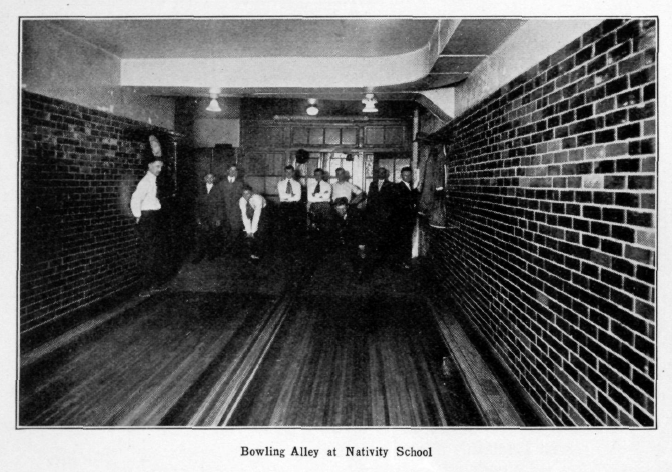
Slovaks in Industry.
While the location of their churches indicates the principal centers of the
race in the city, the original determination of that location was usually
due to its accessibility to manufacturing plants offering employment in the
kind of work which Slovaks are best able to do. The Slovak of Cleveland,
like the members of his race elsewhere, furnishes the fundamental heavy
labor for many of our largest industries. They constitute a large proportion
of the pay-roll in such plants as the American Steel and Wire Company, the
Corrigan-McKinney Co., the Cleveland Hardware Co., the Ferry Cap and Screw
Co., the National Carbon Co., the Mechanical Rubber Co., and the Upson Nut
Co. Their homes are therefore located in districts from which they can
easily reach these plants.
Many of the young women work in cigar and candy factories.
Slovak Citizenship.
As soon as the Slovak has decided to make this country his home, he takes
out "citizen" papers and becomes an American. His doing so is stimulated by
the regulations of the fraternal society to which he belongs and by his
pastor.
The clergy of the Slovak parishes in Cleveland are entitled to great credit
for the influence which they exert in behalf of Americanization. Several of
them have personally conducted citizenship classes, taking their men to the
court for examination; while others have exerted their influence to have
their men take advantage of existing agencies in schools, libraries, etc.
This year (1917-18) classes in English and citizenship were conducted
under the direction of the Americanization Committee, in the parochial
schools of St. Wendelin, St. Ladislas, and Nativity, and in the church of
the Holy Ghost.
At St. Wendelin's a kindergartner was provided to take care of the little
children of the mothers who attended.
At least one-third and in some districts a much higher percentage of the
Slovak men are American citizens.
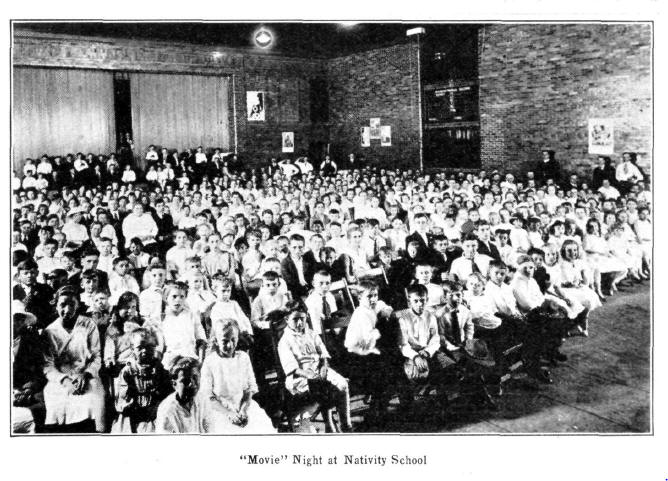
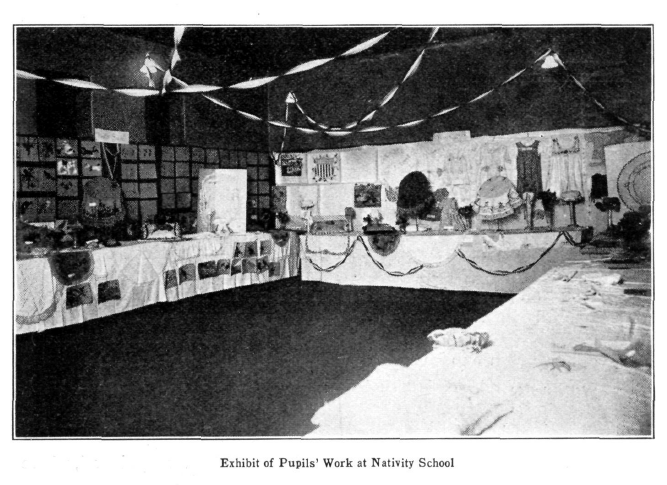
Slovak Publications in Cleveland.
Intelligent citizenship is greatly assisted by local newspapers in their own
language. "Dennik Hlas" (Daily Voice) and the weekly edition "Hlas" extend
to all Slovaks the sturdy Americanism and the true patriotism of the editor,
Mr. John Pankuch, who is known among Slovaks throughout the United States.
It is published at 634-638 Huron Road.
"Nove Slovensko", published at the same address, under the editorship of
Ignace Gessay, is devoted to the interests of the Slovak League.
"Zenska Jednota", (Woman's Union), a semi-monthly, and "Obrana" (Defense),
an illustrated periodical, are published at 5103 Superior Avenue by the Rev.
John M. Liscinsky.
The following books in Slovak have been published by Cleveland authors. The
list is doubtless incomplete. The Americanization Committee will be glad to
receive additions to the list:
Furdek, Stephen . . . Kde se vzal svet? 160 pages, illustrated.
Furdek, Stephen. Svet a jeho zahady. 1910. 249 pages, illustrated.
Furdek, Stephen. Slovak text books for use in Slovak schools.
Horvath, Frantisek.... Sbierka slovenskych piesni. (Slovak songs with
music.) published in Leipzig.
Marshall, Gustav (pseud-Petrovsky). Abrahamova obet ; trans¬lated from the
Dutch of Gustav Jansson.
Marshall, Gustav (pseud-Petrovsky). Z pcd zanejov Arnerickych.
Salva, Karol Tovarysstvo. 3 volumes.
Konig, Janko and Pankuch, Jan Slovensky humoristicky kalendar pre americkych
Slovakov na rok 1915.
Wolf, Antoin. Hlupy Janko.
Other Slovak Publications.
Other Slovak publications of general interest are:
"How to obtain citizenship" in English and Slovak; "Slovensko-Americky
vencek" (Slovak-American song-book).
"Slovak-American Interpreter. Novy Anglicky Tlumocnik pre Slovakov v
Amerike".
These are all publications of the Slovak Press, 166 Avenue A., New York.
Dixon, Charlton Slovak grammar for English speaking students.
Mametej, Albert.Novy Americky tlurnac. (New American Interpreter).
These were both published by Rovaianek in Pittsburgh in 1904.
Kadak, P. K.. Obrazkove dejiny Ameriky (History of the United States).
Scranton, Pa. 1908.
Nyitray, Emil. Slovensko-Anglicky a Anglicko-Slovensky vackovy slovnik.
(Slovak-English pocket dictionary).
Mr. M. N. Soboslay has a Slovak book store at 9722 Buckeye Road, where he
carries books in that language from all over the world.

Public Library.
The Cleveland Public Library has 450 Slovak books, which are in constant use
among the Slovaks of the city, many of whom also read the larger collection
of Bohemian books in the Library.
Slovak Education in America.
The Slovak, who had so little opportunity for education in his own
childhood, appreciates very highly the facilities open to his children in
the schools of this country. It is seldom financially possible for him to
send them farther than the-grammar grades in the first years of life in the
new country, but of course that represents a great gain over what would have
been possible in Hungary. With the acquisition of homes and comfortable
living conditions, the number of children in high school increases very
rapidly. A good many have graduated from business schools, and gone into
office work instead of following their fathers into the factory.
There are as yet only a few professional men among the Slovaks: The
following are apparently the only ones:
J. C. Ferencik, and Gustavus C. Gilbert, attorneys.
M. Francisci, a physician at 3242 Lorain Avenue, and Dr. John A. Filak, now
in the United States service. Dr. Francisci is also widely known as a
musician and composer.
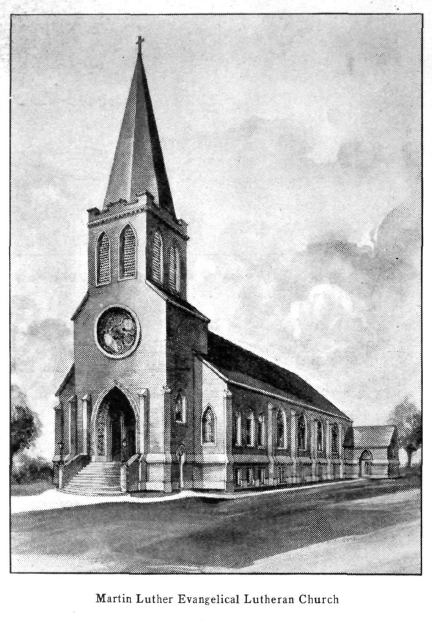
The Slovak as an American.
As a member of the community, the Slovak has in a high degree those
qualities of character which make the solid substantial citizen. He is
nat¬urally conservative, and not inclined to seek changes in the social
order, therefore he has an extremely small representation among the
Socialists, and is never an agitator. Rather his disposition is always to
make the best of things as he finds them. He is simple, direct,
straightforward. The word subterfuge has no equivalent in his language. He
is industrious in a patient, plodding way. In his own country, he worked to
an accompaniment of song. A field of agricultural laborers would sing
folk-songs together as they worked, songs in a minor key, breathing patience
and resignation. Here he is sometimes confused by the speeding-up process,
but adapts himself to it with the same spirit of patient resignation, but
alas, with no opportunity for song.
He buys property, and thus early becomes a tax-payer. He becomes a citizen
and a voter; as yet he has had no desire to share in the machinery of our
political parties, but his understanding of the issues involved in an
election is probably equal to that of the average native-born.
As he cultivates his flourishing "war-garden", he wonders if his friends and
relatives back in Hungary are having anything at all to eat, and he puts all
his soul into the making of the munitions which are to free them from the
yoke of centuries.
Ask one hundred Slovaks why they came to America, and two or three will say
that they came "to see what it was like", while the other ninety-seven or
ninety-eight will promptly give you these three reasons: "To make a better
living, to educate my children, to live under a free government."
Surely these are the best ideals that we can ask of any immigrant.
BIBLIOGRAPHY
Balch, Emily
G.............................................................................
Our Slavic fellow-citizens.
Capek, Thomas.
............................................................................The
Slovaks of Hungary.
Jamarik, Paul........................ Hungary and the future peace
terms;pub. by the Slovak League.
Kulamer, John. ........................................The Life of John
Kollar; pub. by the Slovak League.
Mamatej, Albert..The situation in Austria-Hungary; a reprint of an article
in the Journal of Race
Development. Oct. 1915.
Rovnianek, P. V ........The Slovaks in America. (In Charities, v. 13: p.
239-245, Dec. 3, 1904.)
Seton-Watson, R. W
.................................................................Racial
problems in Hungary.
Steiner, E. A
.............................................................The Immigrant
Tide; its ebb and flow.
p. 93-101. The doctor of the Kopanicze.
p. 124-138. The disciples in the Carpathians.
p. 215-226. The Slav in historic Christianity.
United States Immigration Commission...........................Dictionary of
races or peoples, 1911.
(Article on the Slovaks, p. 132.)
Slovak Newspapers and Periodicals
Published in the United States.
Daily
Dennik Slovak v Amerike...............................................166
Ave. A, New York
Narodny Dennik .............................................4th & Penn Ave.,
Pittsburgh, Pa.
New Yorksky Dennik ............................................502 East 73rd
St., New York
Denny Hlas...................................................... 634-638
Huron Rd., Cleveland
Semi-weekly
Slovak v Amerike.........................................................
166 Ave. A, New York
Weekly
Amerikansko-Slovenske Noviny.............................. 4th & Penn Ave.,
Pittsburgh
Jednota.................................................................................
Middletown, Pa.
Bratstvo ......................................................9-11 E. North
St. Wilkes-Barre, Pa.
Slovensky Hlasnik ........................................1601 Beaver Ave.
N. S., Pittsburgh
Rovnost Ludu ..........................................................1510
W. 18th St., Chicago
Slovensky Pokrok .....................................................309 E.
75th St., New York
Hias
..................................................................634-638
Huron Rd., Cleveland
Narodne Noviny......................................................514
Fourth Ave., Pittsburgh
Katolicky Sokol.................................................... 263
Monroe St., Passaic, N. J.
Youngstownske Slovenske Noviny............... . 239 E. Front St.,
Youngstown, Ohio
Zurnal Spojenych Majnerov ...........................1103 Merchants' Bank,
Indianapolis
Nove Slovensko.................................................. 634-638
Huron Rd., Cleveland
Nove Casy .........................................................1702 So.
Halstead St., Chicago
Semi-monthly
Obrana
...................................................................1276 E.
59th St., Cleveland
Slovensky Sokol ........................................................1424
Vyse Ave., New York
Zenska Jednota........................................................ 1276
E. 59th St., Cleveland
Prehl
ad...................................................................................
Middletown. Pa.
Monthly
Svedok..........................................................................................
Streator, Ill.
Zivena................................................................ 2007
S. Ashland Ave., Chicago
Kruh Mladeze................................................ N. S. S 524
Fourth Ave., Pittsburgh
Slovenska Mladez
...............................................................Box 1704,
Pittsburgh
Ave Maria............................................................... Box
2301, Bridgeport, Conn.
Prehl'ad...................................................................................
Mt. Pleasant, Pa.
Priatel' Dietok.............................................................
115 Hill St., Boonton, N. J.
Udalosti Sveta
................................................................................Hazleton,
Pa.
Dobry Pastier....................................................... .78
Brook St., Bridgeport, Conn.